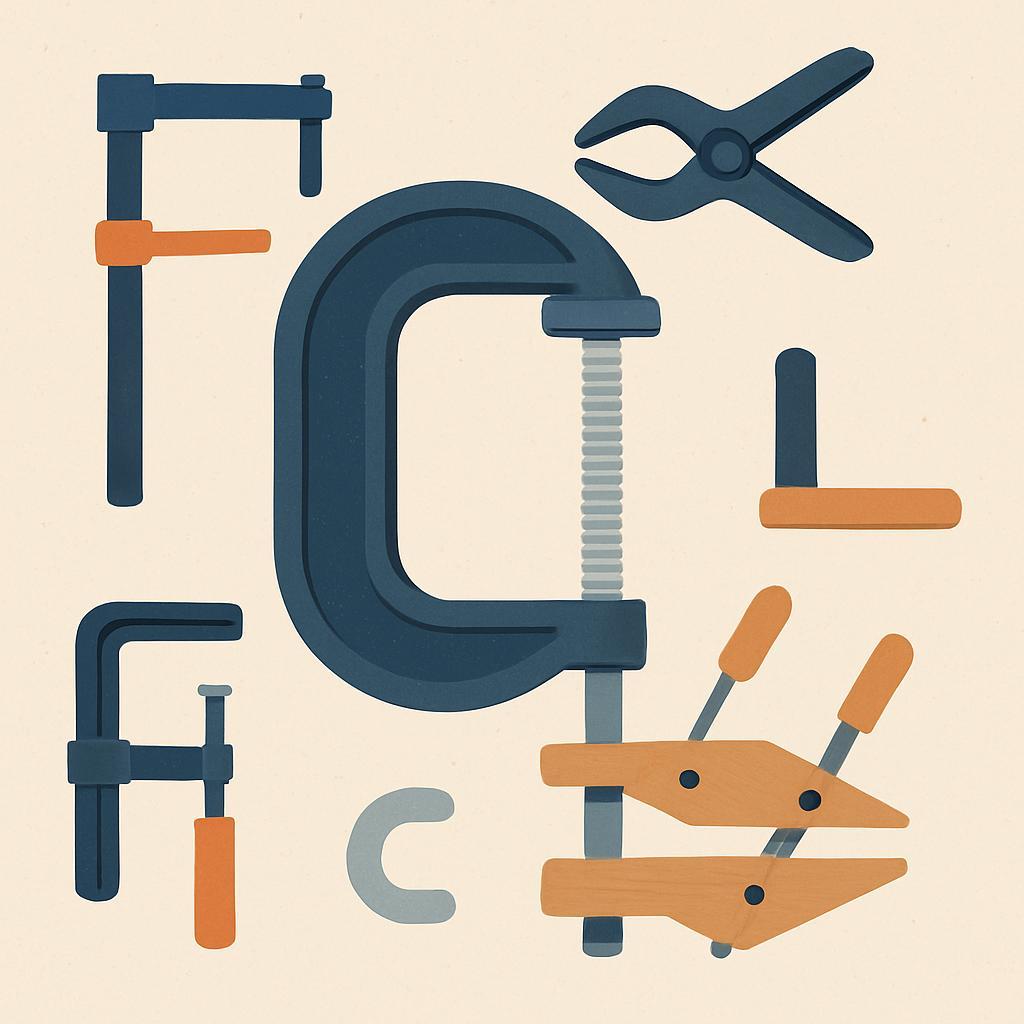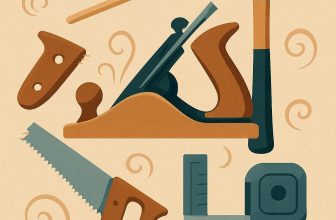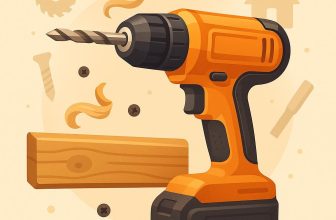
What holds yoru next project together when the sawdust settles and the glue starts its stubborn grip? Clamps. They're not just tools; they are the quiet engineers of accuracy, the difference between planed edges and bowed disasters.For woodworkers, understanding when to reach for a bar clamp versus a spring clamp can save time, money, and nerves. In this article, you'll learn how to distinguish clamp families, what each type is best for, and practical rules of thumb for choosing and using them. You'll gain a clear framework for selecting clamps by job-frame joints, glue-ups, dadoes, and finish work-and tips to avoid common clamping mistakes while keeping your shop safe and efficient.
Understanding Clamp Categories and Their Core Strengths
Clamp categories cover a spectrum of holding power, reach, and speed. Each category has a core strength that makes it shine in particular tasks.C-clamps deliver high force in tight spaces, ideal for small parts and stubborn joints. Bar clamps offer steady, even pressure along a straight edge, perfect for panel glue-ups. Pipe clamps extend reach and scale up clamping pressure with your pipe length, great for large assemblies.Other families, like spring clamps and locking pliers, excel at quick positioning and mobile holds, while toggle clamps and parallel clamps lock or position with repeatable accuracy. Understanding these core strengths helps you predict how a tool will behave before you even set the glue.
Choosing the right clamp is about size, surface, and the type of joint.For long edge gluing, favor bar clamps for even pressure; for distant corners, pipe clamps. For delicate laminates or furnishings, pair parallel clamps with protective pads to avoid indentation. For fixtures that are reused across multiple parts, toggle clamps deliver quick, repeatable seating. And for mobile operations, locking pliers offer one-handed versatility, though they are less forgiving on finished surfaces.
To translate category strengths into action, use a simple decision flow: Step 1 Evaluate the workpiece size and glue type; Step 2 Pick a primary clamp category that covers the reach and pressure; Step 3 Add a secondary clamp to distribute load and guard against bowing; Step 4 Check alignment and adjust pressure gradually to avoid overtightening. Remember to protect delicate finishes with pads and plan for material movement in real-world conditions.
| Clamp Category | Core Strength | Typical Use | Notes |
|---|---|---|---|
| C-clamp | High force in tight spaces | Small joints, mortises | Can leave marks if overtightened |
| Bar clamp | Even, distributed pressure along a bar | panel glue-ups, frames | Requires straight edges |
| Pipe clamp | Long reach with scalable pressure | Large assemblies | Setup slower; requires pipe length |
| Spring clamp | Speed and prep holds | Temporary positioning | Limited clamping force |
| Toggle clamp | Repeatable quick-securement | jigs and fixtures | Mounting accuracy matters |
| Parallel clamp | Parallel jaws for even load | Flat panel glue-ups | Heavier and longer setup |
Build Your Dream workshop on a Budget →
Selecting the right clamp for Woodworking Metalworking and More
Choosing clamps isn't just a matter of grabbing the first tool within reach; it's about matching the clamp to the task, the material, and the finish you want. For woodworking, you'll often prioritize flat bearing surfaces and gentle pressure that won't bow boards, while metalworking typically pushes for higher clamping force and precise, square contact.Think about the impact on your workpiece: will the jaws bite cleanly, or could they leave marks? Planning ahead helps you avoid surprises on glue-ups, milling, or finishing steps.
Different projects cry out for different hardware. Quick-release clamps save time when you are assembling jigs, while C-clamps deliver steady pressure in tight corners. For longer spans,bar clamps or pipe clamps spread force evenly along the edge. If you need repeatable holds on a jig, toggle clamps or magnetic bases offer speed and consistency with the right setup. Below is a concise snapshot to guide your choice, from budget picks to precision tools.
| Clamp Type | Best For | Key Pros | Notes |
|---|---|---|---|
| C-Clamp | Small workpieces, tight corners | Strong bite, affordable | Protect with pads to avoid dents |
| Bar/F-Clamp | edge gluing, longer spans | Even pressure, quick positioning | Bulky but reliable |
| Pipe Clamp | Very long assemblies | Infinite length, strong squeeze | Requires setup to stay square |
| Toggle Clamp | Jigs and repeatable holds | Fast engagement, solid lock | Best on flat work surfaces |
| Spring Clamp | temporary holds, light pressure | Fast, easy to reposition | Limited clamping force |
From a protection standpoint, the difference between a scratch and a blemish often comes down to the contact surfaces.Use protective pads, leather or rubber jaw covers, or tape to cushion delicate wood edge grain. For metal, consider soft jaws on the clamp, and be mindful of magnetism near sensitive parts. When selecting clamps for mixed materials, swapping in soft jaws or adding sacrificial panels is a quick way to preserve finishes without slowing work.
To pick the right clamp in practice, start with a quick checklist: assess workpiece size and required pressure, consider whether you need speed versus control, decide if you'll clamp repeatedly (favor toggles or quick-release), and factor in budget and maintenance. Test a couple of options on scrap stock before committing to a purchase, and organize a small set that covers woodworking and metalworking use cases.
Build Your dream Workshop on a Budget →
When to Use Each Clamp Type for Secure and Precise Results
Choosing the right clamp starts with the task at hand. For secure and precise results, assess clamping force, surface protection, and how long you need the pieces to stay in position. If you're assembling parts that require glue, aim for devices that distribute pressure evenly and avoid leaving marks, such as soft-pad bar clamps or C-clamps used with protective pads. When your work depends on keeping edges square,prioritize stability and alignment over raw squeezing power.
Two workshop workhorses cover most woodworking clamping needs: C-clamps (G-clamps) for tight spots and flexible, short spans, and bar clamps (F-clamps) for long glue-ups and wide pieces. Use protective pads to cushion delicate surfaces, and avoid over-tightening-look for a light, progressive resistance rather than a sudden bite. This helps prevent denting and keeps joints flush as the glue sets.
| Clamp Type | Best For | Pros | Cons |
|---|---|---|---|
| C-clamp | Small parts, corners | compact grip, strong hold | Hard to square long pieces |
| bar clamp | long stock, glue-ups | Even pressure along length, quick adjust | Bulky, edge marks without pads |
| Toggle clamp | Repeatable positioning & jigs | Fast, repeatable | Limited pressure range |
For repeatable setups and quick repositioning, locking pliers (vise-grips) and quick-release toggle clamps shine. they grab securely yet release with a twist, making adjustments efficient without re-strapping.Keep a few soft jaws or pads on hand to protect finishes, and don't rely on them for stubborn, high-tension holds. for light, flexible holds, spring clamps are ideal – they save space and minimize marking while keeping parts together during layout or glue curing.
When your work involves panels, edges, or metal parts, consider specialty clamps that fit the job: edge clamps pull boards tight along edges, face clamps provide wide, flat pressure for large assemblies, and magnetic or pneumatic clamps offer fast, high-pressure holds where manual clamping is impractical. As a best practice, test clamp pressure on a scrap piece first, and always distribute pressure to avoid bowing or misalignment. With the right mix, you'll achieve firm, precise joints without chasing gap or slip.
Build Your Dream Workshop on a Budget →
common Clamping Mistakes and How to Avoid Them
Bad contact and poor alignment are among the most common clamping mistakes. Too many clamps bite only at a corner,leaving joints with gaps or a skewed edge. The antidote is purposeful planning: lay out clamp points before glue, ensure even contact across the face, and prefer wide, flat jaws paired with protective padding to keep the surface true.
Over-tightening is another frequent pitfall. it can squeeze out too much glue, bow the stock, or crush fibers, especially with soft woods or thin stock. Practice a 'fingertip-tight, then a touch more' approach: tighten until the piece sits firmly without creating a visible bow, then tune with additional clamps if needed.When using several clamps, distribute pressure evenly rather than cranking a single one hard to failure.
Surface protection is often neglected. Clamp faces without padding can leave impressions, and glue squeeze-out can smear finish if not wiped promptly.To avoid this, place scraps of wood, felt pads, or even cardboard between jaws and stock, and keep the glue line clean. Wipe away excess glue before it hardens; a quick check along the joint helps catch thin glue lines early.
mismatch between clamp type and task causes hidden issues. Each clamp family behaves differently with stock shapes and thickness. For long panels,use multiple clamps and consider spacers to keep jaws parallel; for tight corners,C-clamps or bar clamps with rotating heads can reach where spring clamps cannot. When in doubt, test-fit first on scrap stock to confirm the clamping plan.
| Common mistake | Quick fix |
|---|---|
| Uneven contact | Plan clamp layout; use padding; ensure flat jaws |
| Over-tightening | Use finger-tight + small turns; check joint for bow |
| Surface damage | pad jaws with scrap/ felt; wipe glue promptly |
| Wrong clamp for task | Match clamp type to stock and joint; test on scrap |
Build Your Dream Workshop on a Budget →
Safety and Maintenance Tips to Extend Clamp Life
Regular safety checks keep clamps reliable and prevent accidents. Before every session, perform a pre-use inspection for cracks in the yoke, bent jaws, damaged screws, or burrs that could mar workpieces. Wipe away dust and resin, then run a quick test by gently tightening to ensure smooth action. Always wear eye protection when adjusting hardware and never use a clamp that shows excessive rust or misalignment. A clean, dry clamp performs better and lasts longer.
Maintenance basics: keep threads clean, lubricate according to type, and avoid cross-threading which can lock the mechanism. Wipe the surfaces that contact the workpiece to avoid transferring oil, and store clamps in a dry area.For most metal clamps, a thin synthetic grease on threads or a light dry lubricant gives smooth action without attracting dust. Aluminum models frequently enough appreciate minimal lubrication to avoid corrosion or buildup.
| Clamp Type | Recommended Lubricant | Notes |
|---|---|---|
| C-Clamps | Thin machine oil on threads; wipe excess | Inspect screw wear regularly |
| Bar clamps | Light grease or dry lubricant on rails | Keep rails clean to prevent slipping |
| Spring Clamps | Typically no lubrication; if needed, a tiny dab on pivot | Test tension periodically |
To minimize wear during use, follow these practical steps:
- Pad the jaws with scrap wood or protective liners to distribute pressure and protect surfaces.
- Align parallel to the workpiece and avoid twisting the clamp as you tighten.
- Avoid over-tightening; use the minimum force required to hold securely.
- After clamping, wipe away residues and inspect for any signs of wear.
storage and replacement: after use, wipe clamps clean and dry them thoroughly, then store in a dry, organized rack. Regularly check for bent jaws, stripped threads, cracked yokes, or rust that affects performance. If a clamp shows persistent looseness, visible damage, or reduced clamping force even after maintenance, replace it to avoid compromising projects.
Build Your Dream Workshop on a Budget →
Practical Setup Guidance for Quick and reliable Holds
When you set up a hold, the goal is quick, repeatable pressure that won't shift under a cut or drill. start by surveying the workpiece and the base surface: are you clamping a flat panel, a narrow edge, or a curved piece? choose clamps that can reach the hold points without crowding adjacent work, and add sacrificial stock or soft pads to protect the surface. The key is distributing pressure evenly across the contact area and avoiding over-tightening that could bow or mar the material.
Plan your clamp layout before you touch the lever. Do a dry-fit first with no clamps, then line up the piece with a square or straight edge. Place sacrificial or protective pads where the jaws meet the material to prevent dents. Position clamps near the ends of the piece for long panels,and use opposing clamps to keep surfaces flush. When tightening, go in small increments and check for parallelism; a single uneven clamp can cause binding or a misaligned hold. for quick setups, keep commonly used clamps within arm's reach and label them by project type.
| Clamp Type | Best Use | Key Tip |
|---|---|---|
| Bar clamps | Flat panels; long reach | Pad the jaws to avoid marring |
| C-clamps | Small corners; compact holds | Protect surfaces with pads |
| Pipe clamps | Large or thick stock | Use padded jaws or scrap stock |
| Spring clamps | quick, light holds | Keep pressure modest |
To ensure reliability, couple clamps with other holding methods when necessary: use a cam toggle or plan for a back-up clamp, or secure the piece in a bench vise for added rigidity. After clamping, perform a quick movement test: gently wiggle and tap along the joint to confirm the hold remains stable. If any creep is detected, add an extra clamp or reposition to restore even contact pressure. Protect the work surface with pads and avoid overtightening, which can distort the piece or obscure measurements.
Maintain a reliable setup long-term with a clean, organized workspace. Regularly inspect clamp pads and jaws for wear, replace worn parts, and store clamps by type to speed up future jobs.A simple pre-check routine helps ensure quick, repeatable holds: a dry-fit, surface protection, and a test hold before any cutting begins.
- Dry-fit the piece without clamps to confirm alignment
- Protect surfaces with pads or sacrificial stock
- Test the hold with a light wiggle before any operation
Build Your Dream Workshop on a Budget →
Q&A
What are the main clamp types and what are they best for?
clamps come in several styles, each with a specialty. C-clamps use a screw to apply precise pressure on a small contact area. Bar clamps (also called F-clamps) run on long rails for wide pieces and even pressure. For quick holds, spring clamps and locking pliers offer fast, one-handed actions.
When should I use a bar clamp versus a C-clamp?
Bar clamps are ideal for long pieces and boards that need even pressure along a seam, thanks to their long rails. They maintain alignment during gluing or assembly while distributing force over a wide area. C-clamps are compact,quick to adjust,and great for small jobs or situations where space is tight.
How do I choose the right clamp size and pressure for a project?
Pick a clamp with a length longer than the piece and a throat depth that reaches into the area you want to hold. Consider the clamping force needed for the material; wood can take a bit of pressure, while delicate pieces may need gentler pressure and protective pads. Always use pads or scrap to prevent marring and avoid over-tightening, which can warp or crush the work.
What are common mistakes to avoid when using clamps?
Avoid over-tightening, which can damage material or squeeze out glue. Misaligning clamps leaves uneven pressure and may cause gaps or skew. Don't skip protective pads or scrap, and check that jaws are clean and square before tightening.
In Conclusion
Clamps are not mere accessories but the quiet partners of every cut, glue-up, and finish.The key takeaway is simple: selecting the right clamp for the job transforms rough materials into precise assemblies, boosting safety and finish quality.Different clamps shine in different tasks-pinch-tighteners for delicate alignment,quick-grip for rapid holds,bar clamps for long panels,C-clamps for stubborn corners-understanding their roles lets you work cleaner and smarter. For woodworkers, this matters because consistency and control translate to better joints and less waste. So try a project with a new clamp, dive into more guides, and map your clamps to the tasks.Your next piece awaits-steady, secure, satisfying.







Great breakdown of clamps! It’s so helpful to know the best type to use for different projects-I always struggled with that.
Thanks for sharing such a comprehensive guide! I’ve always found choosing the right clamp to be confusing, but this post clarifies it all.
This is exactly what I needed! I’ve been stuck using only one type of clamp, but now I feel confident to explore others for better results in my woodworking projects.
This is such a valuable resource! I never realized how many options there are and when to use each type; it’s going to totally enhance my crafting experience.
This is an amazing guide! I’ve often been overwhelmed by the variety of clamps available, but now I feel empowered to select the right one for my specific needs-thanks for making it so clear!
This guide is fantastic! I never knew there were so many different clamps and their unique uses; it’s going to make a huge difference in my DIY projects!
This is super helpful! I’ve always hesitated to try different clamps, but now I can see how each type serves its own purpose; I can’t wait to incorporate this knowledge into my future projects!
What an eye-opener! I’ve always been stuck in my ways with clamp selection, but this post has inspired me to experiment with different types for better efficiency and results in my work-thank you for breaking it down so clearly!
This post is a game changer! I always felt lost among all the clamp options, but now I have a clearer understanding of which ones to use for different tasks; I especially appreciate the practical examples provided!
What a valuable resource! I’ve always found clamp selection a bit daunting, but this post has truly simplified it for me. I love how the different types are laid out with practical usage tips; I’m excited to apply this knowledge to my next projects!
What an incredible guide! I had no idea there were so many types of clamps or how crucial each is for different tasks-this is going to boost my confidence in tackling my next project!
This is such a fantastic overview! I always felt overwhelmed by the variety of clamps out there, but now I feel much more equipped to choose the right one for any job-thanks for making it so clear and approachable!
This is such a helpful resource! I’ve always been confused about which clamps to use when, but your explanations make it so straightforward. I can’t wait to put this knowledge to use and improve my projects-thank you!
This is exactly what I needed! I’ve been struggling with clamp choices for years, and your detailed explanations really clarify everything. I feel ready to tackle my upcoming projects with confidence now-thank you for sharing such valuable information!